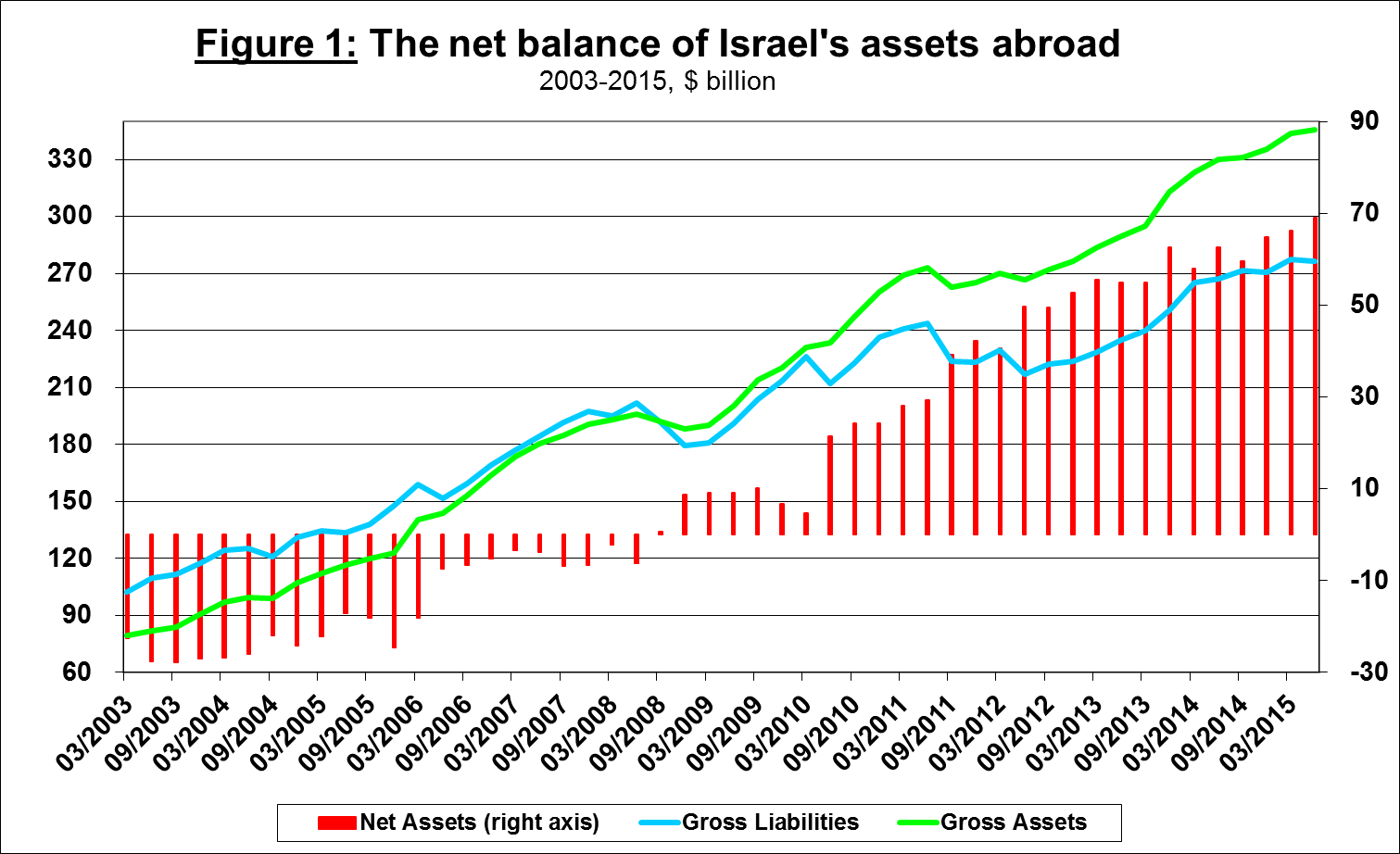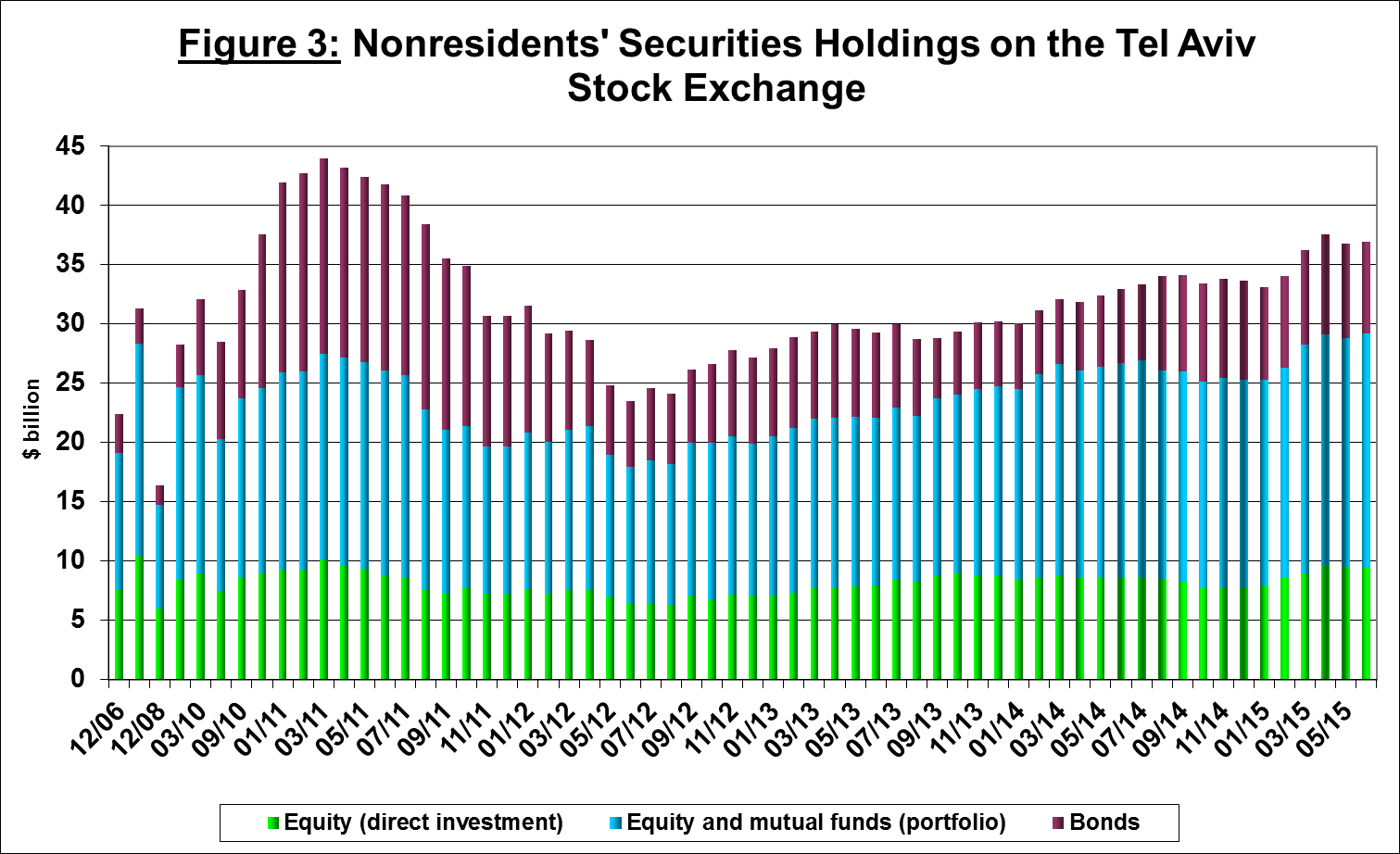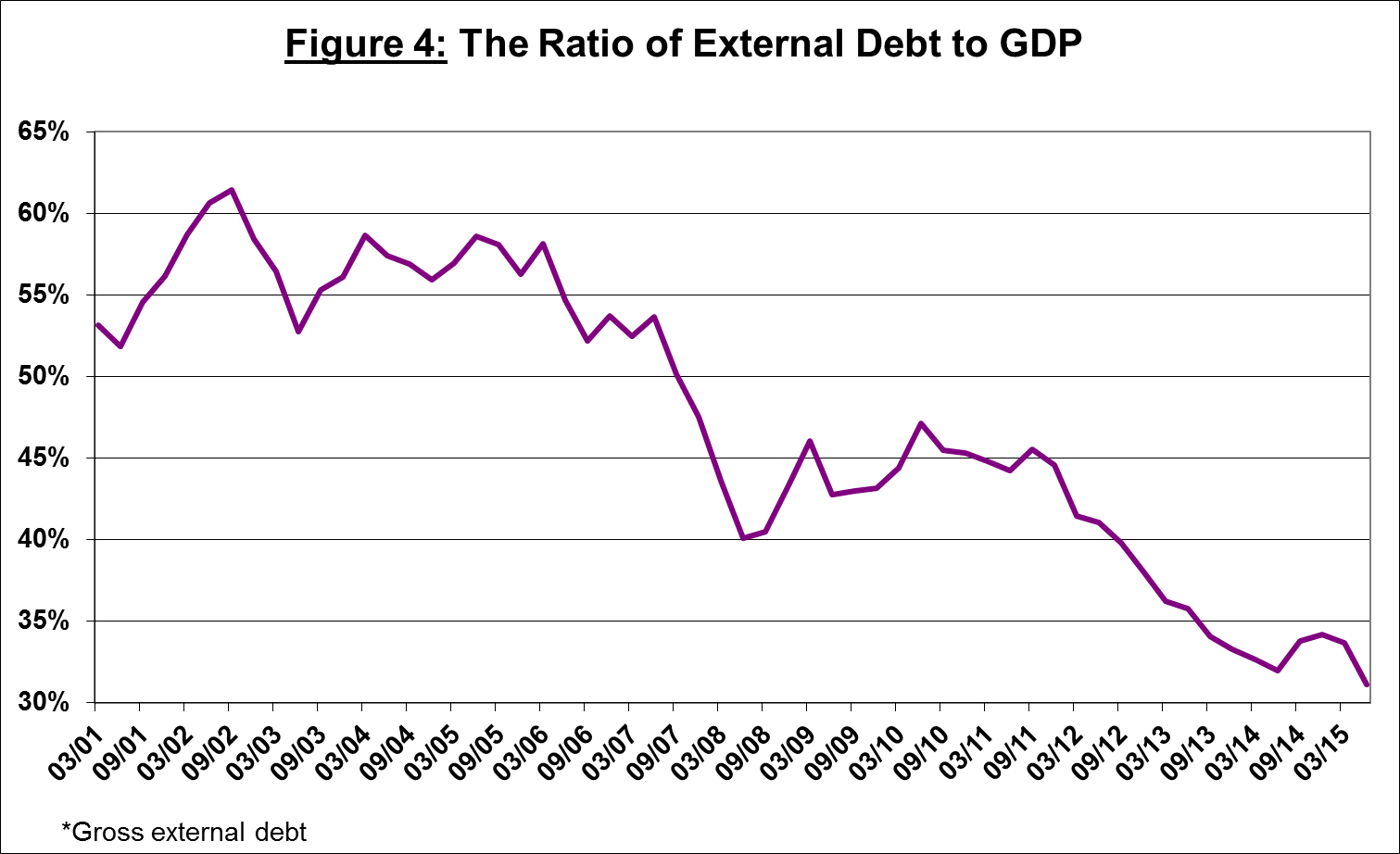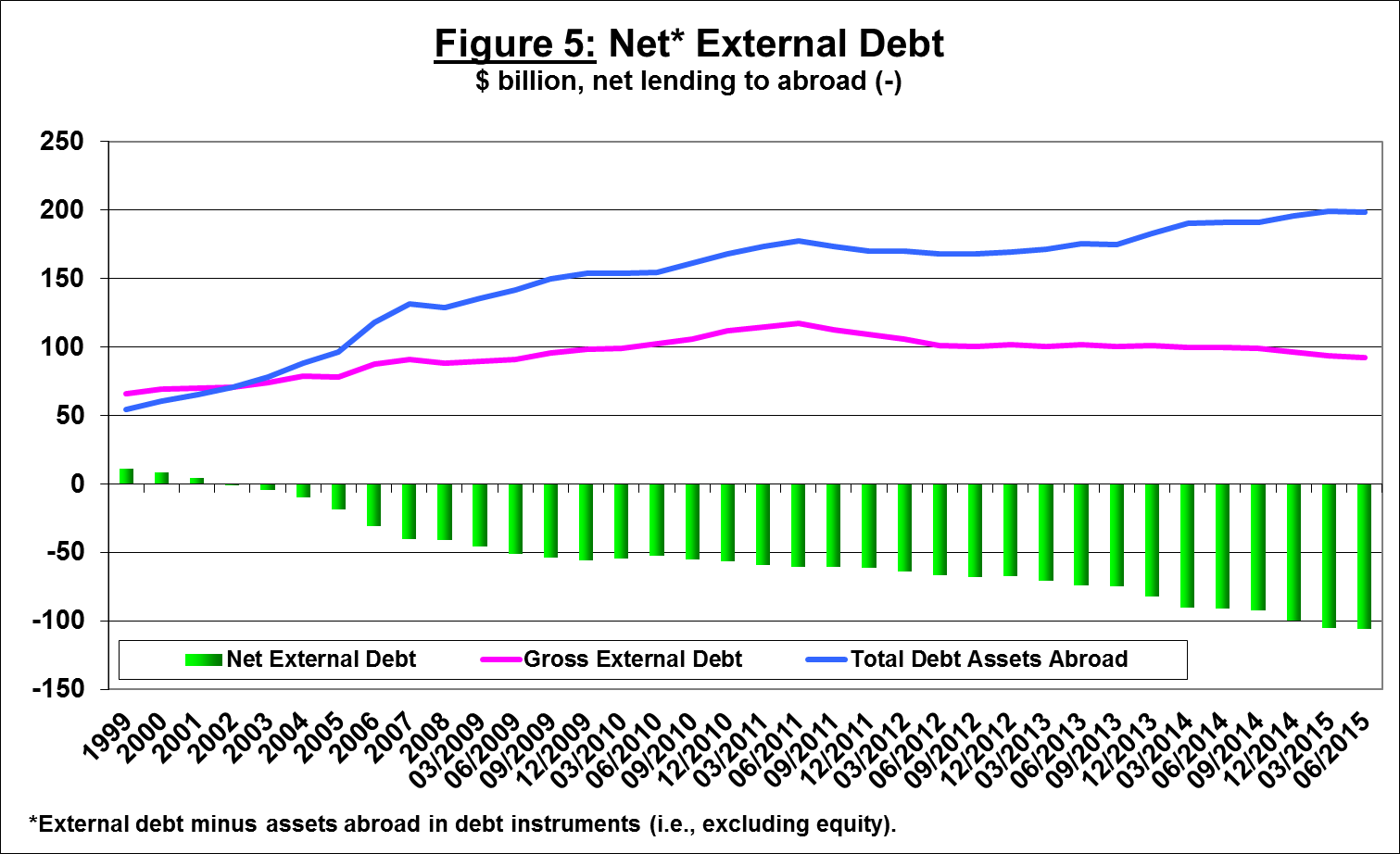· In the second quarter of 2015, Israel’s surplus of assets over liabilities vis-à-vis abroad increased by about $2.7 billion (about 4.1 percent), further to the increase of about $1.5 billion (2.3 percent) in the first quarter of the year.
· An increase of $1.8 billion (about 0.5 percent) in the value of Israelis’ assets abroad was accompanied by a decline of about $1 billion (about 0.3 percent) in the value of Israelis’ liabilities to abroad.
· The increase in the value of assets was mainly the result of foreign exchange purchases by the Bank of Israel and the effect of the exchange rate on reserve assets (a total of $3.7 billion, about 4.3 percent), but was also the result of the flow of financial investments in foreign bonds traded abroad ($1.4 billion, about 2.7 percent). These investments were partially offset by withdrawals by Israeli banks from their deposits abroad ($4 billion, about 2.5 percent).
· The decline in the gross balance of liabilities to abroad derived mainly from a decline in the prices of shares held by nonresidents ($4 billion, about 3.2 percent), which was partially offset by the flow of direct investments in Israel ($3.3 billion, about 3.2 percent).
· The gross external debt to GDP ratio declined by 2.5 percentage points in the second quarter of 2015, to about 31 percent at the end of June. The decline derived mainly from a decline in the balance of external debt combined with the effect of the shekel’s appreciation on the shekel value of the debt.
· The surplus of assets over liabilities vis-à-vis abroad in debt instruments alone (negative net external debt) increased by about $0.5 billion (0.4 percent) in the second quarter of 2015, to about $106 billion at the end of June.

Israel's net assets abroad (the surplus of assets over liabilities) increased by $2.7 billion (about 4.1 percent) during the second quarter of 2015, to around $69 billion at the end of June. An increase of about $1.8 billion (about 0.5 percent) in the value of Israelis’ assets abroad was accompanied by a decline of about $1 billion (0.3 percent) in the value of Israelis’ liabilities to nonresidents (Figure 1).

The value of Israel's assets abroad increased in the second quarter of 2015 by about $1.8 billion (0.5 percent), to about $346 billion at the end of June, mainly reflecting an increase in foreign exchange purchases by the Bank of Israel and the effect of the exchange rate on reserve assets, in parallel with an increase in the flow of financial investments by Israeli residents in tradable assets (mainly bonds). These effects were partially offset by Israeli banks’ withdrawals from their deposits abroad.
The value of the shares portfolio increased by about $1 billion (1.6 percent) during the second quarter of 2015, mainly due to the effect of the shekel’s appreciation on the dollar value of the portfolio, totaling about $420 million, and the net flow of investments by Israeli residents, totaling about $330 million.
The balance of investments in tradable bonds abroad increased by about $1.9 billion (3.8 percent) in the second quarter of 2015, mainly due to the net flow of investments of about $1.4 billion.
Other investments abroad declined significantly during the second quarter of 2015, with net withdrawals by Israeli banks from their deposits abroad totaled $4 billion (25.2 percent), and a decline in customer credit totaling $1.7 billion (8.2 percent).
The value of foreign exchange reserves increased by $3.2 billion (3.8 percent) in the second quarter of 2015. Bank of Israel foreign exchange purchases totaling $2.4 billion were accompanied by an increase of about $1.4 billion in the value of the foreign exchange reserves, affected by the weakening of the dollar against major currencies.
In terms of the composition of residents' securities portfolio abroad, there was a decline in the share of bank deposits in the second quarter of 2015, in contrast with an increase in the four previous quarters. In contrast, the increase in the share of investments in foreign tradable securities (stocks and bonds) continued (Figure 2).

The balance of Israel's liabilities to abroad declined during the second quarter of 2015 by about $1 billion (0.3 percent), to about $277 billion at the end of June, mainly due to a marked decline in the prices of Israeli shares held by nonresidents.
The value of nonresidents’ direct investment in the Israeli economy increased during the second quarter by $3.5 billion (3.5 percent), mainly the result of the flow of direct investment in share capital ($2.5 billion, 2.5 percent).
The value of nonresidents’ financial investments (stocks and bonds) declined significantly during the second quarter by about $.29 billion (2.3 percent). A marked decline in the prices of Israeli shares held by nonresidents ($4 billion, 3.2 percent) was partially offset by the effect of the exchange rate on the securities portfolio (about $1.5 billion, 1.2 percent).
The value of other investments in the Israeli economy decline in the second quarter by about $1.6 billion (2.9 percent), due to declines in deposits (nonresidents and foreign banks), loans and credit of about $500 million on average in each channel.
The value of nonresidents' financial portfolio on the Tel Aviv Stock Exchange increased in the second quarter of 2015 by around $0.7 billion (2 percent), to about $37 billion at the end of June. Nonresidents invested about $0.7 billion in shares, and realized around $0.4 billion in bonds and makam (Figure 3).

The gross external debt
Israel's gross external debt declined by about $1 billion (1 percent) during the second quarter of 2015, reflecting nonresidents’ withdrawals from deposits in Israeli banks, and a decline in loans and credit. The appreciation of the shekel partially offset this decline.
The ratio of gross external debt to GDP declined by 2.5 percentage points in the second quarter of 2015, to 31.1 percent at the end of June, further to a decline of 0.5 percentage points in the first quarter of the year (Figure 4). The decline derived mainly from a decline in the balance of external debt, combined with the effect of the shekel’s appreciation on the shekel value of the debt.

The net external debt
The surplus of assets over liabilities abroad in debt instruments alone (negative net external debt) increased by about $500 million (0.4 percent) in the second quarter of 2015, and reached about $106 billion at the end of June (Figure 5).

The balance of short-term debt assets was about $135 billion at the end of the second quarter of 2015, mostly in the foreign exchange reserves, reflecting a coverage ratio of 3.6 of short-term debt, a slight increase compared to the first quarter of the year.
For the complete data file, click here.